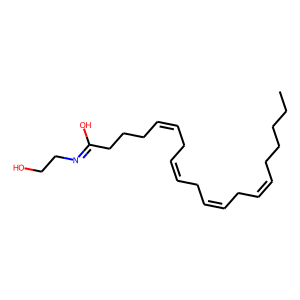Compound Description
| ID: C0898 | Common name: Anandamide |
| IUPAC: (5Z,8Z,11Z,14Z)-N-(2-hydroxyethyl)icosa-5,8,11,14-tetraenamide | CAS: CAS:94421-68-8 |
| Chembl ID: CHEMBL15848 | Pubchem ID: CID:5281969 |
| Formula: C22H37NO2 | TCM-ID: TCMC689 |
| Smiles: CCCCC/C=C\C/C=C\C/C=C\C/C=C\CCCC(=NCCO)O | |
| Alias:
5,8,11,14-Eicosatetraenamide, N-(2-hydroxyethyl)-, (all-Z)-;
(5Z,8Z,11Z,14Z)-N-(2-Hydroxyethyl)-5,8,11,14-eicosatetraenamide; Anandamide; Arachidonoyl ethanolamide; Arachidonylethanolamide; N-(2-Hydroxyethyl)arachidonamide; N-(2-Hydroxyethyl)arachidonylamide; N-Arachidonoylethanolamide; N-Arachidonoylethanolamine; N-Arachidonylethanolamide; N-Arachidonylethanolamine |
Structure:

|
Related Targets (Total: 8)
| Target id | Protein Name | Gene Symbol | Uniprot ID | Target Level | No.of Literature Evidence |
|---|---|---|---|---|---|
| T67KTV | Transient receptor potential cation channel subfamily V member 1 | TRPV1 |
Q8NER1 |
A | 1 Reference(s) |
| T95LIF | Cannabinoid receptor 2 | CNR2 |
P34972 |
A | 3 Reference(s) |
| T17E49 | Cannabinoid receptor 1 | CNR1 |
P21554 |
A | 6 Reference(s) |
| T90QV5 | Voltage-gated hydrogen channel 1 | HVCN1 |
Q96D96 |
A | 1 Reference(s) |
| T34ZZ0 | Potassium channel subfamily K member 2 | KCNK2 |
O95069 |
A | 1 Reference(s) |
| T21DZX | Amine oxidase [flavin-containing] A | MAOA |
P21397 |
A | 1 Reference(s) |
| T06Q1R | Amine oxidase [flavin-containing] B | MAOB |
P27338 |
A | 1 Reference(s) |
| T58TOI | Apolipoprotein D | APOD |
P05090 |
B | 1 Reference(s) |
*In this table, target level represents the quality confidence indicators of targets.
Level 'A' represents "Directly inhibit/activate".
Level 'B' represents "Indirectly inhibit/ activate", "Enzyme substate" and "Enzyme product".
Level 'C' represents "Up/Down regulation" and "Others".
Level 'A' represents "Directly inhibit/activate".
Level 'B' represents "Indirectly inhibit/ activate", "Enzyme substate" and "Enzyme product".
Level 'C' represents "Up/Down regulation" and "Others".
Related Herbs (Total: 6)
| Herb id | Chinese Pin Yin | Chinese Character | English Name | Latin Name |
|---|---|---|---|---|
| H0850 | Zi Su Ye | 紫苏叶 | Common perilla leaf | Perilla frutescens var. arguta |
| H0736 | Yi Dian Hong | 一点红 | Sowthistle tasselflower | Emilia sonchifolia |
| H0849 | Zi Su Geng | 紫苏梗 | Common perilla stem | Perilla frutescens var. arguta |
| H0360 | Ren Zhong Bai | 人中白 | Human urine sediment | Homo sapiens |
| H0847 | Zi He Che | 紫河车 | Human placenta | Homo sapiens |
| H0943 | Dan Cai | 淡菜 | Mussel | Mytilus edulis |
Ckey description of the interaction between compound and target